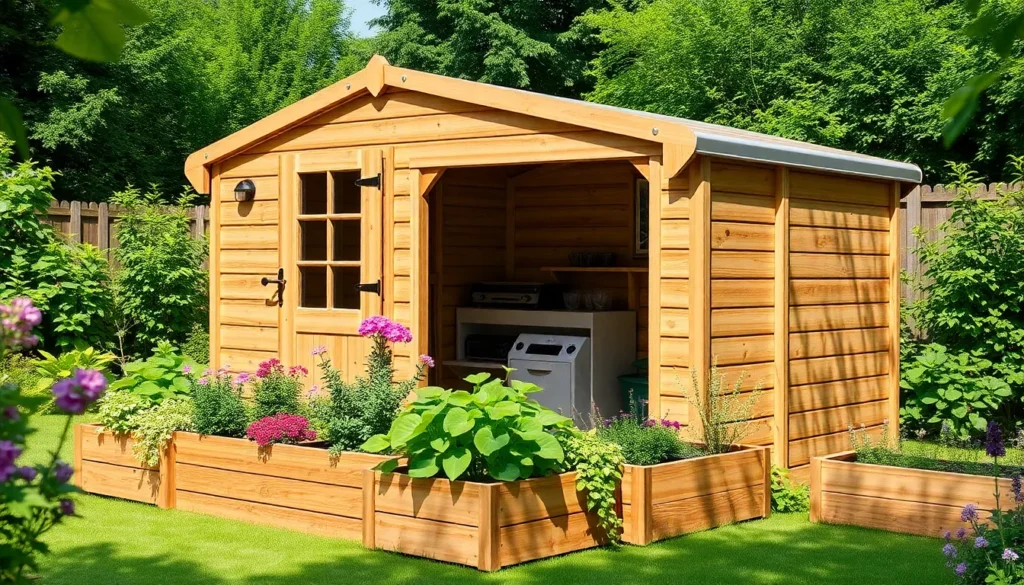Imagine living in an apartment where your morning coffee doesn’t just wake you up but also saves the planet. Sustainable apartment living isn’t just a trend; it’s a lifestyle choice that combines eco-friendliness with modern comforts. From energy-efficient appliances to community gardens, it’s all about making small changes that add up to a big impact.
Table of Contents
ToggleWhat Is Sustainable Apartment Living?
Sustainable apartment living integrates eco-friendly practices into daily life within urban settings. This concept focuses on actions that reduce environmental impact while promoting a healthy lifestyle. Residents of sustainable apartments often prioritize energy conservation by using energy-efficient appliances.
Recycling programs play a crucial role in waste management. Engaging in proper recycling can decrease landfill waste significantly. Many communities also support composting initiatives to further reduce organic waste and enrich soil health.
Green building materials are common in sustainable apartment designs. These materials are sourced responsibly and have lower environmental footprints. Features such as solar panels and rainwater harvesting systems enhance energy efficiency.
Community gardens represent another aspect of sustainable living. Residents participate in growing their own food, fostering connections among neighbors, and encouraging biodiversity. Access to green spaces improves mental well-being and supports local wildlife.
Transportation choices also matter greatly. Residents often utilize public transportation, bicycles, or car-sharing services to reduce dependence on personal vehicles. These options contribute to lower carbon emissions and improved air quality.
Water conservation aids in sustainable living. Simple practices, such as fixing leaks and utilizing low-flow fixtures, help minimize water usage. Communities encourage awareness of water-saving habits to protect valuable resources.
Sustainable apartment living creates a holistic approach to urban life. By embracing eco-friendly practices, residents contribute to a healthier planet while enjoying the benefits of modern conveniences. Active engagement in these practices fosters a sense of responsibility and community.
Benefits of Sustainable Apartment Living
Sustainable apartment living offers numerous advantages that enhance both individual lifestyles and the environment. These benefits can be categorized into environmental impacts and economic advantages.
Environmental Impact
Sustainable practices significantly reduce carbon footprints. Using energy-efficient appliances decreases energy consumption. Incorporating renewable energy sources, like solar panels, minimizes reliance on fossil fuels. Recycling and composting reduce waste, diverting materials from landfills. Community gardens enhance urban biodiversity, providing habitats for various species. Choosing public transportation or cycling lowers greenhouse gas emissions. Water conservation techniques, such as rainwater harvesting, protect vital resources. Collectively, these actions contribute to a healthier ecosystem and promote sustainable urban areas.
Economic Advantages
Cost savings emerge as significant benefits of sustainable apartment living. Lower energy bills accompany the use of energy-efficient appliances. Access to government rebates for solar panel installation can provide financial incentives. Reducing water usage leads to decreased utility costs. Community gardens often lower grocery expenses while fostering local food production. Sustainable living can boost property values due to heightened demand for eco-friendly features. Furthermore, improved health outcomes result in reduced medical expenses over time. Embracing sustainability in housing creates a more economically viable future for residents.
Key Features of Sustainable Apartments
Sustainable apartments incorporate various features that significantly enhance environmental responsibility. These elements focus on energy efficiency, water conservation, and the use of sustainable materials.
Energy Efficiency
Energy-efficient appliances play a crucial role in sustainable apartments. They reduce energy consumption while maintaining modern conveniences. LED lighting significantly lowers electricity usage compared to traditional bulbs. Smart thermostats allow residents to optimize heating and cooling, further decreasing energy costs. Additionally, building designs might include improved insulation that keeps units comfortable year-round. Implementing solar panels generates renewable energy, contributing to a reduced carbon footprint. Conducting energy audits ensures that any inefficiencies are identified and addressed effectively.
Water Conservation
Water conservation is a vital aspect of sustainable apartment living. Low-flow fixtures in kitchens and bathrooms minimize water usage without sacrificing performance. Many developments integrate rainwater harvesting systems to utilize natural precipitation for irrigation and non-potable needs. Native landscaping reduces the need for extensive watering, promoting biodiversity while conserving resources. Greywater recycling systems provide an alternative water source for irrigation. Utilizing drought-resistant plants in community gardens further supports sustainable practices by lowering overall water demands. These strategies collectively protect precious water resources.
Sustainable Materials
Sustainable materials contribute positively to both the environment and indoor air quality. Choosing recycled or reclaimed building materials minimizes waste and decreases the demand for new resources. Bamboo flooring and recycled metal fixtures are examples of eco-friendly options. Paints and finishes that emit low or no volatile organic compounds enhance the air quality inside apartments. Additionally, incorporating sustainable insulation materials helps regulate temperatures efficiently. Many developments prioritize sourcing local materials, which reduces transportation emissions and supports local economies. The smart selection of sustainable materials fosters healthier living environments.
How to Choose a Sustainable Apartment
Choosing a sustainable apartment involves several key factors that prioritize eco-friendly living.
Important Considerations
Location significantly impacts a building’s sustainability. Proximity to public transportation reduces reliance on cars, lowering carbon footprints. Look for apartments utilizing green building standards. Energy-efficient appliances and renewable energy sources contribute to lower utility costs. Evaluate water-saving features, such as low-flow fixtures and rainwater harvesting systems, to conserve precious resources. Inspect for sustainable materials, including recycled or reclaimed options, to ensure a healthy living environment.
Resources for Finding Sustainable Apartments
Several platforms assist in locating sustainable apartments. Websites like Green Building Council and EcoBrokers specialize in listing eco-friendly homes. Local listings often provide details about energy efficiency and green certifications. Joining community groups on social media can connect potential renters with like-minded individuals sharing insights on sustainable living options. Moreover, exploring regional sustainability initiatives can highlight available apartments, bridging the gap between eco-conscious choices and urban living.
Tips for Enhancing Sustainability in Your Apartment
Enhancing sustainability in an apartment involves adopting practical eco-friendly practices and fostering community engagement. Small yet impactful changes lead to a more sustainable lifestyle.
Eco-Friendly Practices
Energy-efficient appliances such as LED bulbs and smart thermostats significantly lower energy consumption. Incorporating low-flow faucets and showerheads reduces water usage while maintaining comfort. Composting organic waste creates nutrient-rich soil, benefiting both indoor plants and community gardens. Utilizing reusable products like bags, bottles, and containers minimizes plastic waste. Residents might also consider participating in local recycling programs, which facilitate waste reduction. Planting indoor plants improves air quality and creates a calming atmosphere. It’s crucial to leverage natural light whenever possible, reducing dependence on artificial lighting.
Community Involvement
Engagement in community gardens fosters social connections and promotes biodiversity. Organizing neighborhood clean-up events encourages residents to take pride in shared spaces, enhancing the environment. Residents might host workshops focused on sustainability, cultivating knowledge and collaborative solutions. Joining or forming local sustainability groups allows individuals to share resources and information. Taking part in local farmer’s markets supports sustainable agriculture and reduces food miles significantly. Advocacy for green initiatives with local government can lead to improved infrastructure for sustainable living. Encouraging communication among neighbors aids in sharing eco-friendly practices, fostering a supportive environment.
Sustainable apartment living offers a pathway to a healthier lifestyle and a greener planet. By embracing eco-friendly practices and fostering community connections, residents can significantly reduce their environmental impact. Small changes like using energy-efficient appliances and participating in local gardening initiatives create a ripple effect that benefits everyone.
Choosing a sustainable apartment not only enhances personal well-being but also contributes to the long-term viability of urban areas. As more individuals prioritize sustainability, the collective efforts lead to improved ecosystems and economic savings. Ultimately, sustainable living is about making informed choices that promote harmony between modern life and the environment.










